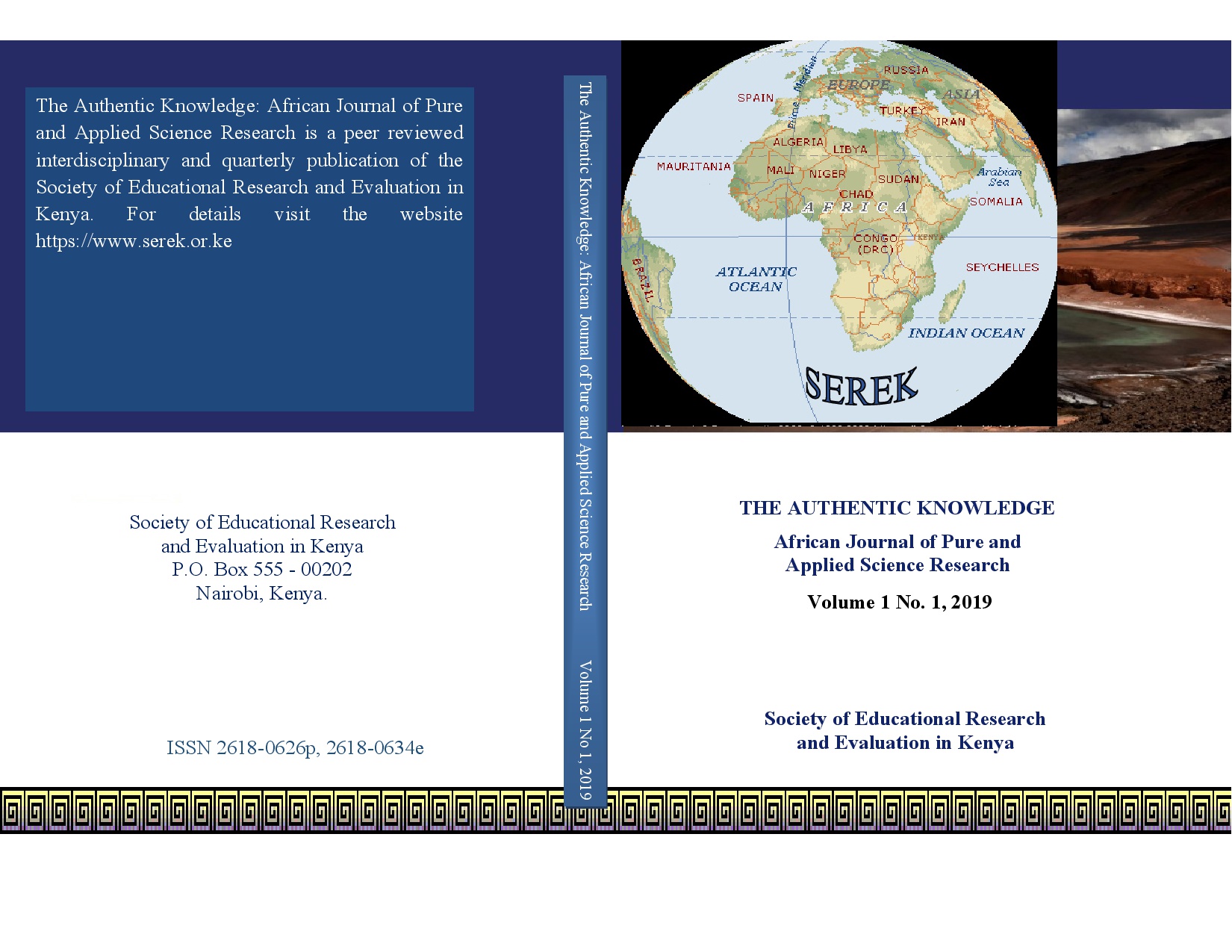
Influence of Institutional factors on Adoption of Improved Cassava Processing Technologies among Small Scale Farmers in Migori County, Kenya
Abstract
Cassava is a key food crop, a cheaper raw material for animal feed and has various industrial uses. However, cassava utilization is faced with some challenges in that; once harvested, it is perishable if not processed, it is also bulky and has high cyanide concentration. Processing can increase its utilization. In Kenya, improved cassava processing technologies have been developed but their adoption continue to be low especially among small scale farmers. This paper therefore establishes the influence of institutional factors on adoption of improved cassava processing technologies in Kuria-West and Suna-west Sub-Counties. Eight wards were purposively selected based on the magnitude of cassava production, 120 cassava small scale farmers were proportionately and randomly selected. An interview schedule was used to collect data that was analyzed. Data analysis was done using descriptive statistics and binary logistic regression to test the hypotheses at a level of significance of p ≤ 0.05. Institutional factors of this study explained 20.8% variation in adoption. The Chi-Square value was significant at .000. Therefore, null hypothesis which stated that, selected institutional factors [access to extension services, credit access and group membership] have no statistically significant influence on the adoption of improved cassava processing technologies by small scale farmers in the study area was rejected.The findings of the study can be a basis for interventions to help farmers adopt technologies and guide the government and policy makers in formulating strategies to address the challenges faced in processing and utilization of cassava.
Keyword: Adoption, Institutional factors, influence, small scale farmers, Technologies
Full Text:
PDFReferences
Achieng, F. O., Dannenberg, P., & Willkomm, M. (2017). Characterization of the Levels of Cassava Commercialization Among Smallholder Farmers in Kenya: A Multinomial Regression Approach. African journal of agricultural research, 12(41) 2-12.
Ali, A.; Rahut, D.B (2013). Impact of agricultural extension services on technology adoption and crops yield: Empirical evidence from Pakistan. Asian Journal of Agriculture and Rural Development, 3 (4) p.801–812.
Allem, A. (2002). The Origins and Taxonomy of Cassava. Brazilian Agricultural Research Corporation, 1-16.
Balagopalan, C. (2002). Cassava Utlization in Food, Feed and Industry. In R. I. Hillok , & J. M. Thresh, Cassava Biology, Production and Utilization (pp. 301-318). Wallingford: CAB Intl.
Beshir, H. (2014). Economics of Soil and Water Conservation: The case of smallholder farmers in North Eastern Highlands of Ethiopia Ethiopia. The experiment,23 (3), 1611-1627
Peng, C.J., Lee, KL.,& Ingersoll, G.M. (2002). An introduction to logistic regression analysis and reporting. Journal of Educational Research 96(1): 3-13.
Climate-Data.Org. (2018, July 20). Climate Data Oganisation. Retrieved from CLIMATE DATA FOR CITIES WORLDWIDE: https://en.climate-data.org/
County Government of Migori. (2015). County Government of Migori County. Retrieved from Department of Agriculture Livestock and Water Development: http://migori.go.ke/index.php/78-migori-county-departments/86-agriculture-livestock-and-water-development
Dada , A. D. (2012). Evaluation of Technological Capability and Innovations in the Nigeria Cassava Processing Industry. Rio de Janeiro: Research Network on Local Productive and Innovative Systems.
Ehinmowo, O. O. (2016). Adoption of Improved Cassava Processing Technologies by Women Entrepreneur in South – West, Nigeria. World Journal of Agricultural Research,4 (4) 109-113.
FAO. (2013, July 21). Food and Agricultural Organisation for United Nations. Retrieved from http://www.fao.org/faostat/en/#data/QD Accessed on June 2018.
Hillocks , R. J., Thresh, J. M., & Bellotti, A. (2001). Cassava : biology, production, and utilization. Wallingford: Centre for Agriculture and Bioscience International.
Karuri, E. E., Mbugua, S. K., Karugia, J., Wanda, K., & Jagwe, J. (2001). Marketting Opportunities for cassava based products: An Aseesment of the Industrial Potential in Kenya. Cornell University, 1-59.
Melesse B., (2018). A Review on Factors Affecting Adoption of Agricultural New Technologies in Ethiopia. Journal of Agricultural Science and Food Research, 9(3) 1-4
MoALF&I. (2007). Ministry of Agriculture, Livestok, Fisheries and Irrigation. Retrieved from National policy on cassava industry (policy reforms to improve production, research, marketing and regulation in the cassava industry: https://kilome.files.wordpress.com/2014/07/kenya-draft-cassava-policy.pdf
Ogola, T.D.O., Nguyo, W.K. & Kosgey, I.S. (2010). Dairy goat production practices in Kenya: Implications for a breeding programme. Egerton University, Kenya. Available on: http://www.Irrd.org/Irrd22/1/ogo122016.htm. Accessed on 10th March 2019.
Rousan, L. M. (2007). Factors Influencing Adoption of Improved Farm Practices among Women Farmers in Northern Jordan. American-Eurasian J. Agri. & Env. Sci.,20(5), 220-226.
Ullah,A., Khan, D., Zheng, S., & Ali, U. (2018). Factors influencing the adoption of improved cultivars: a case of peach farmers in Pakistan. Journal of Ciência Rural, Santa Maria, 48 (11), 1-11.
Wanyama, J. M., Obare, A.G., Owuor, G., Wasilwa, L.(2013). Factors Influencing Adoption of Tissue Culture Bananas in Western Kenya. A Research Paper presented at an International workshop for 4th conference of AAAE in Tunisia
Refbacks
- There are currently no refbacks.
License URL: https://www.serek.or.ke
SEREK publication https://serek.or.ke
This work is licensed under a Creative Commons Attribution 4.0 International License